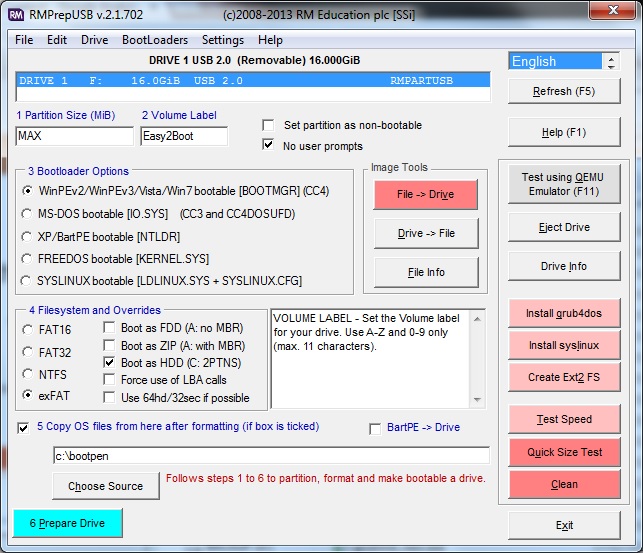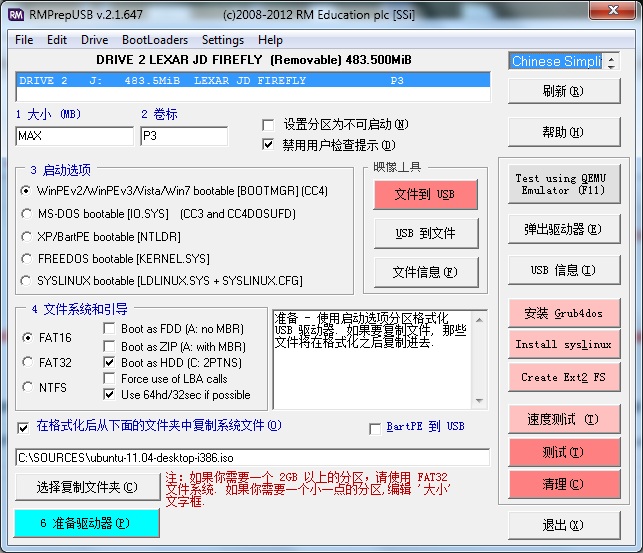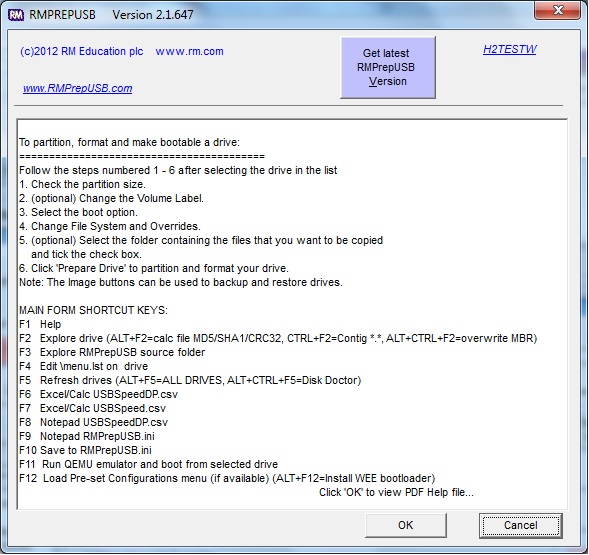RMPrepUSB - Home Page
Please note: These are pages from the old site which are no longer maintained!
If no pictures, please use the special URL for this site as specified in Easy2Boot Book #1.

Make your USB drive bootable by using RMPrepUSB
Saving files is up to 10% faster if you first format your SD card or Flash drive using RMPrepUSB (FAT32).
Over 140 Tutorials on this site (in chronological order).
Please use the Search box to find the article you want or expand the Tutorials list.
Note: RMPrepUSB and RMPrepUSB tutorials can also be used with non-USB drives too (just press ALT+F5 in RMPrepUSB to switch to ALLDRIVES mode).
'Getting started with grub4dos' - eBook PDF (2020): Complete grub4dos guide with exercises and full command reference.
Try Easy2Boot to make a multiboot USB drive (free)
Just copy ALL and ANY .iso, .img, .ima, .vhd, .wim, ima.gz files, all Linux LiveCD ISOs and Windows Install ISOs to your USB drive and boot from any of them. Automatic menu system each time you boot. Just copy over your files (or delete them) and boot - no special utility required, no linux cheat codes. Fully documented and highly configurable.
Secure UEFI multi-booting is also supported.
New - E2B eBooks (all in PDF format)!
eBook #1: How to make a multiboot USB drive using Easy2Boot - a complete course on how to make a multiboot USB drive
eBook #2: How to install Microsoft Windows using Easy2Boot - install Microsoft Windows unattended, with drivers + applications
eBook #3: How to make a UEFI multi-boot Easy2Boot USB drive How to set up your E2B drive so that it UEFI-boots and allows you to select any .imgPTN file. (assumes you have read the first eBook - contains download links to required UEFI boot files)
eBook #4: E2B #4: UEFI-multiboot using the a1ive grub2 File Manager (agFM) - Now your E2B drive can Secure UEFI boot and then directly UEFI-boot from your ISOs, VHDs, etc.!
Getting started with grub4dos - Complete grub4dos guide with exercises and full command reference.
Read more: http://www.easy2boot.com/download/ebook/
NEW! Tutorial 142 - Restore your Windows (UEFI\GPT) OS in 5-10 minutes with just one key press (uses CloneZilla).
RMPrepUSB does not need to be installed however it does write some settings to the Registry when you exit the application. These settings are removed from the Registry when you uninstall RMPrepUSB.
RMPrepUSB was originally developed for RM Education customers. RM Education plc have given permission for it to be publicly released - this website is maintained privately by the author to continue its development.
RMPrepUSB and RMPartUSB are freeware utilities but are for private use only - no registration is required and all versions are unlimited and do not contain any adware, PUPs or viruses.
Do not distribute these utilities without permission - RMPrepUSB and RMPartUSB are not 'copyright free', 'free software', 'Open Source' or 'Open Licence' products, but they are commercial applications which are made available by RM Education plc for public, non-commercial use at zero cost.
Licensing
Commercial use (i.e. selling RMPrepUSB or including it as part of your own product) and/or re-distribution is forbidden and you need to contact RM if you wish to include or re-distribute it as part of a commercial solution. Email: [email protected] Classroom Technologies department, for all user licence enquiries.
Please note: No licence is required for the internal use of RMPrepUSB by technicians/engineers within a company.
Most Popular Tutorials on this Site
Tutorial #89 Automated System Restore - Ever wanted to have a way of pressing a key on booting from your PC or Notebook and restoring an image of your Windows installation in just a few minutes just like the PC manufacturers do. Here is how to do it very easily using CloneZilla and it's free! Multiple image backups are easily done too (a USB flash drive is only used to prepare hard disk). Two videos are available to show you how.
Tutorial #54 How to fix write-protected disks - Has one of your disks become write-protected? This tutorial describes some ways to fix it.
Tutorial #7 All about 'Fake' SD cards and USB Flash drives
Tutorial #39 How to re-program the firmware on USB Flash drives
Tutorial #29 Boot Hirens Boot CD as an ISO from a USB drive
Tutorial #36 Boot Hirens Boot CDfrom a USB drive
Tutorial #83 Download ImageX, BCDBoot and other WAIK tools without having to download the whole WAIK
Tutorial #76 Quickly setup PXE booting to install any Windows OS or PXE boot linux, etc. using SERVA
Tutorial #77 How to create a multiple partition USB Flash drive under Windows
Tutorial #53 Windows 8 To Go! - Download Windows 8 Consumer version to a USB drive and boot from it to try Windows 8 out. Unlike previous versions of Windows, Windows 8 is already configured to run from a USB drive - if you have a USB 3 drive, why not test out booting Windows 8 from a USB 3 port and see how fast USB 3 really is!
Tutorial #36 Boot the Hirens Boot CD (v13-v15) from your USB drive - The Hirens Boot CD is an illegal (though CDs can be found for sale on eBay!), cut-down version of Windows XP which will run from a USB drive. This tutorial shows you how to make a bootable USB drive by extracting and copying the Hirens to your USB drive. You can then boot directly from your USB drive and access most Windows computers.
Tutorial #43 Install Windows Vista, Windows 7 or Server 2K8 R2 from a USB Flash drive - This popular tutorial allows you to have a USB Flash drive which can install any or all of these Windows OS's to a system's hard drive just by copying of the ISO files. This means you can carry all the ISO files on just one USB pen drive and install any version you want on any system you want. Of course, you will have to activate Windows in the normal legal way after installation.
Tutorial #47 Boot Windows 7 directly from a USB drive - This tutorial describes how you can install Windows 7 directly onto a USB drive (preferably a USB hard disk as Flash drives are very slow!). You can then plug the USB disk into another system that does not have a working internal hard drive and boot directly to Windows 7 from the USB hard drive.
Tutorial #21 GRUB4DOS TUTORIAL - This tutorial introduces you to grub4dos. Grub4dos is used in most of my tutorials and it is a boot loader and menu system that allows you to create a multi-boot USB drive. Once you become familiar with grub4dos menus, you can easily create a bootable USB drive. RMPrepUSB has features which allow you to easily install and edit menus for this very popular utility.
Tutorial #63 Install Windows 7 AND XP from the same USB drive - This tutorial effectively combines Tutorials #47 and #30 into one. Just download the one files and unzip it, then add your XP ISO file and Windows 7 ISO file and you can then install either XP and/or Windows 7 onto any system you like! Why not make a dual boot system?
Tutorial #24 Ultimate Boot CD for Windows - this tutorial contains instructions on how to make a cut-down version of XP using an XP SP2 or SP3 CD or ISO file using the UBCD4Win utility. You can either extract the files from the ISO file, or if you want to make a multi-boot USB drive you can simply copy the ISO file to the USB drive and boot from the ISO file directly (see 2nd part of tutorial).
Tutorial #9 Boot BackTrack 5 from a USB drive - BackTrack 5 is a very popular linux OS version that can be used to check wireless network security. It also contains a lot of linux network drivers and a working gcc environment (useful for compiling open source linux applications). Note: BackTrack 5 cannot be run directly from an ISO, the contents need to be extracted onto a USB drive.
See the sidebar for many more tutorials - e.g. recovery photos from a corrupt SD card, boot your EeePC to linux (YLMF), clear your BIOS CMOS password, test your computer's memory, erase your hard disk of all data, clean your hard drive of viruses without having to boot from it, etc. etc.
Visit RMPrepUSB Blog or leave a comment or feedback on RMPrepUSB or a Tutorial (please mention the Tutorial number).
WebSite Objectives
To provide a 'free for private use' Windows utility for making bootable USB Flash drives which fixes some of the problems that the HP Format Tool has.
This site is intended to provide users with the latest versions of RMPrepUSB and RMPartUSB and to continue their development.
To provide tutorials, links and 'How To' articles to help you through your journey of discovery into USB Boot-Land!
To provide a 'one-stop shop' for all Windows users for syslinux, grub4dos and bootable USB drive 'roll your own' solutions.
About RMPrepUSB
RMPrepUSB.exe is a front end graphical user interface (see screenshot Fig. 1 below) for the Windows command line program RMPartUSB.
RMPartUSB.exe is a command line Windows program that can access USB (and non-USB) storage devices, e.g. flash memory (UFDs) or USB hard disks or USB card readers, and partition and format them to make them bootable.
Supported Operating Systems that will run RMPrepUSB/RMPartUSB include: Windows XP, Vista, Server 2003, Server 2008, Windows 7/8/10 32-bit and 64-bit versions are fully supported. WinPE v2 and v3 is also supported but the Copy OS Files option may not work and you will need to type in the folder path instead. Note: QEMU provides a 32-bit emulated CPU environment only.
Bootable Operating systems: You can make a USB pen that will boot to MS-DOS, FreeDOS, WinPE v1, v2 or v3, BartPE, XP, Vista, Win 7, linux (via grub4dos or syslinux boot loaders). You can also install the WEE bootloader from RMPrepUSB.
Portable - RMPartUSB andRMPrepUSB uses a vb6 DLL which is normally already present in Windows. The Installer version merely copies files and adds Desktop and Start Menu shortcuts, it includes an un-installer but you can just as easily simply delete the folder from your hard drive. These apps do NOT require .NET Framework support or WMI support. The installer and the portable version will add various user-default entries to the registry on exit, but that is the only change made to the registry (no task bar/start-up/browser changes are made).
Useful Terminology
USB - Universal Serial Bus - a specification to allow communication between a device and a host controller
USB Drive - a storage device that communicates via USB
USB Hard Disk - a hard disk that connects to a host controller (e.g. computer) using USB
USB Flash drive - a flash memory dive that connects to a host controller (e.g. computer) using USB
UFD - USB Flash drive
Bootable UFD - a USB flash drive that a computer can boot from instead of a hard disk or CDROM/DVD
Pen drive - a nickname for a UFD
Thumb drive - a nickname for a UFD
Fake USB Flash drive - a USB flash drive that reports its capacity incorrectly and may also contain faulty flash memory.
PBR - Partition Boot Record, contains the boot code and filesystem tables. It is located at the start of a formatted partition and is typically used to boot an OS.
VBR - Volume Boot Record - see PBR - alternative name for PBR
MBR - 512 byte Master Boot Record, contains the initial boot code which determines which partition to boot to. A partition table within the MBR contains details of where the partitions are located and which one is bootable. Floppy disks do not have an MBR. ZIP disks do have an MBR but boot as large (super) floppy drives.
OS - Operating System such as Windows, MS-DOS, FreeDOS, linux, etc.

Fig 1. RMPrepUSB 2.1.702 with exFAT option

Fig. 1a - Select one of 17 languages...

Fig. 2 RMPrepUSB Help form screenshot (includes F11 = Run QEMU emulator, and ALT+F5 = Show all drives)
RMPrepUSB is a user-friendly Windows graphical front-end which calls it's brother application RMPartUSB (which does all the hard work!).
RMPartUSB is a Windows command line utility and does not have a GUI and can be used in batch/script files (type RMPartUSB to see help/usage text in a Windows command console). RMPartUSB makes a partition of any size and is primarily intended for USB Flash Drive (UFD) memory sticks, although it can be used on USB hard drives or USB card readers to create a bootable partition or even non-USB drives. RMPartUSB also places boot code on the USB device for either XP/WinPEv1 (ntldr), Vista/WinPEv2/Win7 (bootmgr), MS-DOS (io.sys) or FreeDos (kernel.sys). RMPartUSB does not place any files on the UFD - you must copy these over yourself or set the Copy OS Files option in RMPrepUSB to copy over the contents of a folder of your choice.
What do the buttons in RMPrepUSB actually do?
Prepare - Runs RMPartUSB which will wipe, partition and format the selected USB drive using the preset options (set by items 1-5). Then copy over files from a preset folder (optional).
USB Info - shows partition info of the selected USB drive (displays any sector)
Quick Size Test - Checks the drive capacity in just a few minutes by writing and reading to certain blocks. This test will DESTROY any files on your USB drive and is not a thorough test, if it passes then use H2TESTW for a thorough test (which can take many hours!)
Speed Test - Reads and writes approx. 63MB of data sequentially to your USB drive to calculate the read and write speed. This test will not destroy any data on your USB drive, however if anything goes wrong you may lose all your drives contents! Results are appended to a CSV file every time it is run, so you can build up a speed library. Note that real life use of the USB drive when using a filesystem will always give slower results. Also, results will vary depending on what OS you have and the USB drivers and chipset used in the mainboard.
Install grub4dos - This installs grub4dos onto your USB drive. You can replace the version shipped with RMPrepUSB with a version of your own by replacing grubinst.exe and grldr in the RMPrepUSB folder, if you like. Grub4dos boot files normally contain a menu.lst file to present the user with menu boot options.
Clean - wipes the first 100 sectors on the USB drive. If your system is having trouble accessing your USB drive, try this option and remove and re-insert the USB drive.
ImageTools
File -> USB - Reads the contents of a binary image file and write it to the USB drive
USB -> File - Reads the contents of the USB drive (sectors) and writes them to a file
Note: These two commands are quite powerful and can be used to save and restore USB drive images (or just partition images or even just single sectors). They can be used in a similar way to dd.exe but more safely. For instance you could replace just the MBR on a USB drive or write a bootrom file to a USB drive (e.g. PXE boot rom). If you are unsure what options to choose, use '0' or the suggested default. v2.1.625+ can also convert virtual drives to raw images and copy these to your USB drive.
File Info - Displays partition information about the MBR (or any sector) on the USB drive
Eject - Ejects the drive so you can safely remove it without causing any filesystem corruption. ALWAYS use this button (or the Windows Safely Remove Drive USB icon in the system tray) before pulling out the USB plug. As long as you do this you should never get a 'corrupted drive - format drive?' message from Windows ever again!
Refresh - re-detects USB drives (RMPrepUSB detects any new drives that are inserted after a few seconds automatically).
Install Syslinux - runs the syslinux.exe command to install the syslinux boot code to the USB drive - does not wipe or format the USB drive.
Create Ext2/3/4 FS - creates a file on the USB stick (e.g. casper-rw) of any name and size which can be recognised and mounted as an ext filesystem by linux OS's. Useful for persistent Live linux OS distros with Easy2Boot.
Test using QEMU Emulator (F11) - uses the 32-bit QEMU emulator to boot your USB drive within Windows. You can boot to linux or WinPE or Windows within a QEMU emulator window. This does not change your system in any way. Useful to test out grub4dos or syslinux menus or check that your USB drive actually boots without needing to unplug it and plug it into another system every time. Note that a 32-bit Intel x86 CPU is emulated and the maximum amount if memory that can be assigned is aprox 900-1100MB. If too much memory is assigned, QEMU will not run correctly.
There are some options that allow the UFD to boot either as a super-floppy (ZIP) drive or a Fixed disk (HDD). Thus DOS or FreeDos can boot from a UFD as either the A: drive or the C: drive depending on how you partition and format it using the options available. These options though are highly dependent on what BIOS you use when you boot the USB drive as there are no BIOS standards for USB booting from Flash media.
What do the boot options in RMPrepUSB actually do?
Set drive as non-bootable - Does not set the Active flag on the first partition - useful if you just want to make a non-bootable UFD so that if left in a system, the system will not try to boot from it when you switch it on.
Size - by default the maximum size for the UFD will be used. If you want a smaller size then change this (e.g. 500)
Volume Label - change this text box to set the volume label.
(the settings below are all BIOS dependant - the BIOS determines how a system boots and each BIOS has a slightly different way of interpreting these options!)
Boot as FDD - No MBR or partition table is used, floppy disk drive number is used in PBR.
Boot as ZIP - Changes some bytes in the Volume Boot Sector Bios Parameter Block table to indicate that the device is a floppy disk and not a hard disk and uses 64hd/32spt translation if possible.
Boot as HDD (2PTNS) - This is usually the best option to choose for a general purpose grub4dos boot drive - it adds a second hidden very small partition to the partition table. Some BIOSes, when they see a UFD with two partitions, automatically assume that the device must be a hard disk (as ZIP removable devices are defined as having a single partition). Selecting this option increases the chances that any BIOS will boot the UFD as a fixed disk rather than as a ZIP disk. Many thanks to online for this discovery!
Force use of LBA calls - Use this option if you have problems booting on certain systems. This option sets the CHS values in the partition table to the maximum value and thus should help to ensure that a BIOS uses 255 heads x 63 sectors per track LBA translation values. If you have problems booting, try ticking or unticking this option. It may work for some systems but not for others.
Use 64hd/32sec if poss.. - if the partition is not too large (<1GB) then RMPartUSB uses 64hds and 32 sectors per track for the partition table values, rather than the standard 255hds/63spt values used in modern LBA (Logical Block Address) systems. Selecting this option or the ZIP option (which also uses this 64/32 option) is often successful in booting a UFD as a ZIP device (A:). If the partition is larger than 1GB then the next translation up is used (e.g. if 1.5GB then 128hds/32spt is used).
Want to know more? Visit the Manual page here. A large and detailed PDF is included with RMPrepUSB (just click on the Help - OK button) or it can be downloaded separately on the Downloads page in this website.
Runs under Windows XP, BartPE, WinPE, Hirens miniXP, WinPE (32-bit), Vista and Windows 7/8 (32-bit & 64-bit)
The ideal utility for grub4dos geeks who like to make their own bootable USB drives!
Boot to MS-DOS, linux, FreeDos, Windows XP/Vista/7/SVR2K8, grub4dos, syslinux, etc.
Create a casper-rw persistent filesystem on your USB drive.
Press F11 and test booting from your USB drive inside Windows using the QEMU emulator.
Quickly test your USB flash drive with RMPrepUSB Quick Size Test. See here for more details.
If your language is not currently supported in RMPrepUSB or you find some of the text missing/wrong,
why not edit and send me your own version of the <language.ini> file?
You can make your own easily - just edit a .\Lang\xxxx.ini text file and test it yourself immediately - it's easy!
Click for RMPrepUSB YouTube Tutorials
Featured in the German com! magazine article (Jan. 2011) which lists several uses of RMPrepUSB.
To read the article, click here and then click on the PDF button. Also see the later full article
on RMPrepUSB at com! magazine article on RMPrepUSB (Sept. 2011 in German).
Tags: Boot, bootable, USB boot, grub4dos, iso, format, partition tool, utility, windows, fat32, ntfs, ext2, windows 7, vista, xp, bartpe, fake flash, test, benchmark, pen drive, thumb drive, rm prepusb, rm prep usb, rmprep usb, prepare, make usb, iso, syslinux, HP Format tool, HP utility, Bootit.exe, Bootit, fat32, ntfs pendrive, fake, iso, zalman, grub, grubfordos, grub4dos, bootland, reboot pro, syslinux, ext2
